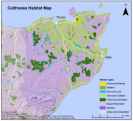|
Introduction Introduction to the Area |
|
|
Introduction to the Area Caithness is a land of open, rolling farmland, moorland and scattered settlements. The area is fringed to the north and east by dramatic coastal scenery and is home to large, internationally important colonies of seabirds. The surrounding waters of the Pentland Firth and the North Sea hold a great diversity of marine life. Away from the coast, the landscape is dominated by open moorland and blanket bog, divided up along the straths or river valleys by more fertile farm and croft land. The underlying geology, harsh climate and long history of human occupation have shaped this rich and distinctive natural heritage. Today we see a diverse landscape incorporating both common and rare habitats and species, and Caithness provides a stronghold for many once common species that have undergone serious declines elsewhere, such as wading birds, water voles and flocks of over-wintering birds. Geology The main rock type is Old Red sandstone, laid down in layers and sculpted by ice and sea to produce some of the most dramatic coastal scenery in the UK. Breeding seabirds such as guillemots, razorbills, kittiwakes and fulmars have exploited the resulting ledges at locations such as the Stacks of Duncansby and cliffs of Dunnet and Holburn Head. Flagstones were an important raw material to Caithness folk, and can be seen all over the county as dykes, floors or roofing materials. During the late 1890s to the 1920s, Caithness flagstone was exported all over the world. Old quarries have been re-opened in recent years to meet a renewed demand. Climate Introduction to Biodiversity Biodiversity, short for 'biological diversity', is a relatively new word that has been coined to express the richness of nature or variety of life. It came into use after the UK government signed up to the Convention on Biological Diversity at the Earth Summit in Rio di Janeiro in 1992. Crucially, biodiversity is concerned with nature and people, and sees the natural world as a vital asset, essential to our survival and quality of life. As a concept, it asks us to use our resources in a sustainable manner, i.e. in a way that doesn't compromise our children's abilities to use them too. "Biodiversity, our planet's most valuable resource, is on loan to us from our children." Highland Biodiversity Project Local authorities and others are being encouraged to take local action to promote biodiversity, to compliment national action programmes and projects. A plan is being prepared for each area of Highland, focusing on the areas of Caithness, Sutherland, Ross & Cromarty East, Wester Ross, Skye & Lochalsh and Lochaber. Inverness & Nairn and Badenoch & Strathspey are already covered by related initiatives. This plan for Caithness has been prepared by the Caithness Biodiversity Group, a group of local people representing a broad range of interests, see inset. It sets out what can be done in the next five to ten years. The plan is non-statutory, i.e. it is not legally binding. However, with increased emphasis being placed on biodiversity and related issues by successive governments, it is widely accepted that such plans will become increasingly important in the targeting of resources and setting of priorities. |
|
